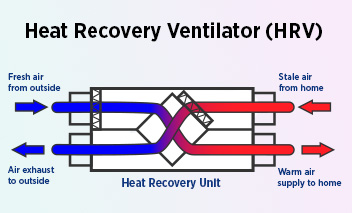How HRV Balances Indoor Humidity
Wiki Article
The All-Inclusive Overview to the Uses of Heat Recovery Ventilation in Modern Structures
Heat Recovery Ventilation (HRV) systems represent a significant innovation in constructing technology (HRV Heat Recovery Ventilation). They supply an approach for trading stagnant interior air with fresh outside air while decreasing power loss. This approach not just improves indoor air top quality however also adds to energy performance in both property and industrial buildings. Understanding the different applications and advantages of HRV can expose its vital duty in modern design and sustainability efforts. The effects of this innovation deserve exploring additionallyComprehending Heat Recovery Ventilation Systems

Although many modern-day buildings prioritize power efficiency, recognizing warmth recuperation air flow (HRV) systems is important for optimizing indoor air top quality and minimizing power intake. HRV systems work by transferring warm from stale indoor air to incoming fresh air, successfully preserving comfortable interior temperature levels while minimizing power loss. These systems are composed of a warmth exchanger, followers, and ductwork that assist in the blood circulation of air. Throughout winter months, HRV units record and recycle heat from the outward bound air, while in summertime, they can assist cool down inbound air. By constantly trading air, HRV systems additionally minimize humidity and the concentration of interior contaminants. Correct installation and upkeep of HRV systems are vital for their efficiency and efficiency in improving general building performance and comfort.
Benefits of Heat Recovery Ventilation
Heat recovery ventilation systems offer numerous advantages that enhance both energy performance and interior air quality in contemporary structures. By recording and reusing energy from exhaust air, these systems significantly reduce cooling and heating prices, causing reduced power intake. They keep a steady circulation of fresh outside air, decreasing the risk of indoor air contaminants and allergens. This continual exchange assists regulate moisture levels, preventing mold development and guaranteeing a healthier living environment. Furthermore, HRV systems contribute to sustainability goals by reducing total carbon impacts. Their capability to enhance ventilation without sacrificing thermal convenience makes them a valuable addition to contemporary building style, advertising both financial and ecological advantages.Applications of HRV in Residential Structures
As homeowners increasingly prioritize power efficiency and indoor air quality, the applications of warm healing air flow (HRV) systems in domestic buildings have actually ended up being a lot more common. HRV systems are especially helpful in firmly secured homes, where maintaining fresh air flow is essential for stopping moisture build-up and indoor pollutants. They properly transfer warm from outward bound stagnant air to incoming fresh air, reducing energy costs connected with home heating and air conditioning. Furthermore, HRVs can boost convenience levels by regulating moisture and temperature. They are likewise adaptable for different residential styles, consisting of single-family homes and multi-unit buildings. Overall, incorporating HRV systems supports sustainable living methods while guaranteeing a much healthier Recommended Site interior setting for occupants.HRV in Business and Commercial Setups
In commercial and industrial setups, the implementation of heat recovery air flow (HRV) systems has come to be increasingly essential for optimizing energy effectiveness and keeping air quality. These systems properly move warm from exhaust air to inbound fresh air, minimizing the need for extra home heating or air conditioning. This not only decreases power prices yet additionally adds to sustainability campaigns. Industries such as manufacturing, warehousing, and office complex profit greatly from HRV systems, as they aid control temperature level and moisture levels, ensuring a comfortable and effective environment. HRV systems aid in getting rid of impurities and excess wetness, improving indoor air high quality. As laws around air high quality end up being stricter, the adoption of HRV technology is most likely to grow, making it a vital element of contemporary industrial and industrial framework.Future Fads in Heat Recovery Ventilation Modern Technology

Often Asked Concerns
Exactly How Does Heat Recovery Ventilation Effect Indoor Air High Quality?
Heat recovery ventilation substantially enhances indoor air top quality by continually exchanging stale indoor air with fresh exterior air while recovering energy. This procedure lowers pollutants, keeps optimal moisture degrees, and ensures a healthier setting for occupants.Can HRV Systems Be Set Up in Existing Buildings?
HRV systems can indeed be mounted in existing structures. Retrofitting may require adjustments to ductwork and air flow formats, however it substantially enhances power effectiveness and indoor air quality, making it a feasible option for older structures.What Maintenance Is Needed for HRV Systems?

Exist Particular Climates Where HRV Is Extra Efficient?
Heat recovery ventilation systems are specifically reliable in climates with substantial temperature level differences in between seasons. These systems enhance energy performance by recuperating warmth from exhaust air, making them suitable for both cool Homepage and reasonably warm settings.Just How Do HRV Equipments Affect Power Bills?

Report this wiki page